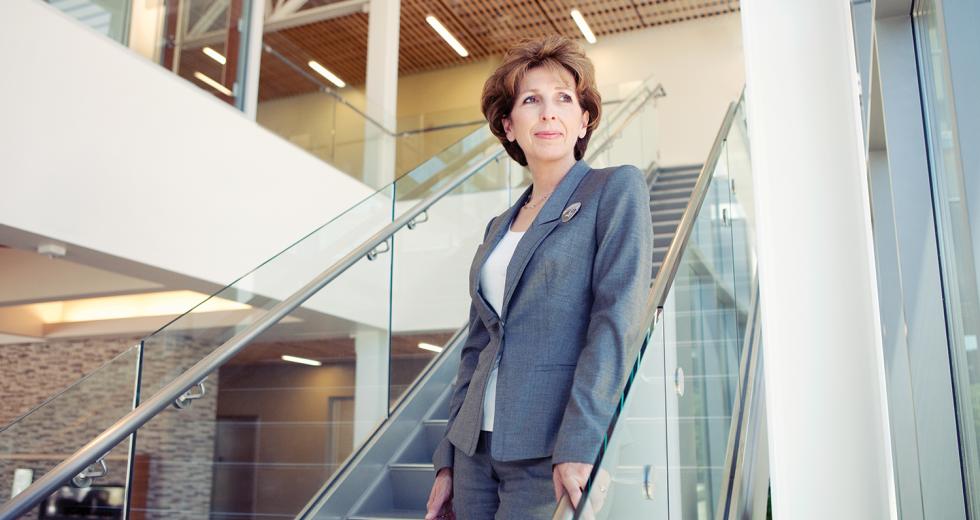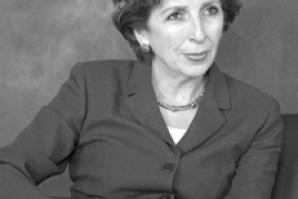While institutions of higher learning across the state are reeling from budget cuts, tuition hikes, course reductions and faculty and student unrest, Chancellor Linda Katehi has calmly put together a business plan for expansion and prosperity at UC Davis.
Having just completed her second full year at the helm, Katehi remains well aware of the financial challenges facing university staff and students, but instead of girding for more state cuts, she is preparing for the day when UC Davis would no longer rely on state funding.
“State funding has been so unstable and uncertain,” she says. “The sooner we get off that dependency, the better we will be.”
To that point, the state budget outlined by Gov. Jerry Brown in January called for a $500 million hit to the University of California system. The patchwork budget approved by the Legislature and signed by Brown in late June calls for an additional $150 million reduction. Another $150 million cut could be triggered in the new year if a projected $4 billion state revenue increase is not realized.
“We almost have to assume that the additional cut will be triggered,” Katehi says. “So we must plan accordingly.”
Her realistic approach to the funding issues facing the university has made big fans of a couple of private sector alumni.
“When it comes to funding, it’s not like she’s playing rope-a-dope with the state. If the state funding drops to 16 percent, so be it. We move on,” says Jack Gualco, president of Sacramento-based lobbying and consulting firm, The Gualco Group Inc., and former member of the UC Davis Foundation board.
Rex Hime, president & CEO of the California Business Properties Association, just completed his term as a regent for the University of California. A proponent of public higher education, Hime says he is frustrated with the Legislature and the governor.
“With this latest cut — for the first time in the history of California — the UC system is no longer a public institution. We now get more money from students than we do from the state,” Hime says. “Fortunately, at Davis, we have Chancellor Katehi. She is able to devise a real-world approach to the towers of learning. Oftentimes, those two axioms do not connect.”
The immediate impact of the latest budget cuts will likely mean an additional tuition hike. An 8 percent increase is already scheduled for the fall semester. Last month, the UC regents approved an additional 9.6 percent tuition hike that, according to Katehi, will also take affect this fall, increasing tuition for California residents to more than $12,200. That’s an increase of more than $1,900 from the 2010-2011 academic year.
For the immediate future, Katehi says not much can be done to stem the continued increase in undergraduate and graduate tuition. However, to ensure continued access and support to UC Davis for California high school graduates and community college transfers, a comprehensive capital fundraising campaign was launched last October. With a four-year goal of $1 billion and 100,000 donors, the campaign is off to a roaring start. According to the chancellor, $700 million from 80,000 donors has already been raised.
“We should be able to reach our initial goal early,” Katehi says. “Then we’ll set our goals for the next level and launch another campaign.”
According to the chancellor, the biggest emphasis of this campaign is to create endowments to fund student scholarships and faculty fellowship programs. She says these endowments are absolutely critical: “To achieve our academic goal of becoming one of the top five research universities in the country, we must have financial stability.”
“State funding has been so unstable and uncertain. The sooner we get off that dependency, the better we will be.”
Linda Katehi, chancellor, UC Davis
With only two sources of unrestricted funds (tuition and endowments) Katehi says the next logical move for UC Davis is to expand its student population. The incoming freshmen class totals 4,700, and there will be about 5,700 transfer students. Total undergraduate student count for the 2011-2012 school year is projected at 24,500, and with the 8,000 graduate students, the total student population will total close to 33,000.
Katehi envisions that number growing to 40,000, which could make it the largest student population in the UC system.
Much of the campus is situated within the city limits of Davis — a city not known for embracing growth. Katehi says communication between the city and the university remains open and cordial. She says the city will be the economic benefactor of any expansion of facilities on campus property, where most infrastructure is already in place. Most importantly, Katehi points out, UC Davis doesn’t need city permission for development that takes place on campus.
“I firmly believe in the next five years we are going to grow by 5,000 undergraduates. That will allow us to hire more faculty. It will grow our graduate programs and allow for additional research opportunities,” she says. “And, it will spur more economic opportunity for the entire region.
Luckily for UC Davis, the conditions for growth here are much different than at the other UC campuses. After all, it’s already invested in nearly 6,000 acres and 117 million square feet of maintainable space.
“If we do this wisely, methodically develop and expand our campus, increase the population of highly qualified resident and nonresident students, and create an ever-growing endowment fund, the business model will work,” Katehi says.
By increasing the number of students paying tuition and the number of out-of-state and international students paying a much higher fee, flow of unrestricted funds increases, over time reducing the gap between the actual cost of education and what a student pays — a gap that used to be filled by the state.
The final piece of Katehi’s master plan is for the university to reduce the cost of providing and maintaining a world-class university experience. Rolled out last year, the Organizational Excellence Initiative intends to achieve just that. All departments and divisions are being asked to determine where costs can be cut through increased efficiencies, eliminating redundancies and the use of new software.
In order to make room for new programs to attract a new breed of students, other existing programs have to be cut or absorbed by other schools and divisions.
“But we’re not simply eliminating programs, we’re consolidating them so they better reflect the needs and desires of today’s students and society as a whole,” she says. “We’re not just restructuring; we’re reforming and revitalizing our academic program.”
While this consolidation effort is taking place, new programs are coming on line. A nursing school has been established, offerings within the School of Education have increased, the Graduate School of Management has a number of new offerings and the number of students participating in the School of Food Sciences’ nutrition program has nearly doubled. Course offerings in environmental sciences and green technology continue to increase, and the development of a technology incubator with the College of Engineering has created quite a buzz (see our iPad app for more on that).
No group on campus has been more impacted by the state budget shortfalls and the restructuring of academic offerings than faculty. Across the UC system, faculty reductions have taken place, pay has been cut and furloughs have been imposed. At UC Davis, total faculty count is down 10 percent from two years ago.
Bob Powell is the chair of UC Davis’ academic senate. He admits the past couple of years have been a difficult time for faculty. In addition to losing colleagues through program cuts and attrition, long time faculty members are being lured away for higher paying jobs elsewhere. According to The Los Angeles Times, the number of firm outside offers to UC Davis faculty doubled to 61 this year from last, and its retention rate dropped from 90 percent to 72 percent as it lost professors to such universities as Brown, New York University, Penn State and Rice.
Between January 2011 and January 2012, the University of California system could lose more than $800 million in state funding.
But despite the unstable financial picture and uncertainty over program reformation, Powell says the faculty remains a tightknit group and maintains much faith in Katehi and her vision for the university.
“Morale is surprisingly good. It’s being tapped daily, but there is a reservoir of good will on this campus,” Powell says. “Chancellor Katehi has brought to the campus a fresh new perspective. Her vision for taking â?¨UC Davis to the highest level of academic achievement through student growth and endowment creation is something we can all rally around.”
UC Davis also hasn’t been immune to student unrest, as large groups of protesters voiced displeasure over tuition hikes last fall and this spring. However, according to Katehi, much of the unrest among students and faculty really had to do with a lack of clear understanding about how the university is funded.
“Students and faculty both did not understand how critical the state contribution is to the university. State funds are basically the only wholly unrestricted funds that we can use to fund educational programs,” Katehi says. “To make up for state budget shortfalls, we can’t dip into research grants or federal funds or monies designated for the medical school. So the only way to cover the state gap is by increasing tuition. Once that became clear, much of the animosity was no longer directed at the university.”
Justin Gold, who graduated in June with a double major in philosophy and political science, agrees with the chancellor’s assessment.
“Initially much of the student population was pretty upset. Having incurred more than a 30 percent tuition and student fee hike over a two-year period, they wanted to take out their frustration on somebody. The university administration seemed like the obvious choice,” Gold says.
As an undergrad assistant to the chancellor’s office, Gold hosted an open forum in which he moderated a panel of university administrators that included Katehi. Students were encouraged to ask questions regarding state funding and all other matters financial.
“After that, the campus became saturated with information. Students were allowed space to share information and vent frustrations,” Gold says. “There are still upset students, but they now realize the problems lie within the state budget, not the university.”
With this realization, Katehi, her staff, faculty, alumni and donors continue to pursue a business model that will diversify sources of funding, reduce the cost of education and dramatically enhance the overall academic experience.
“You don’t become a great university by cutting,” she says. “Instead, you need to come up with creative solutions. That’s what we intend on doing.”
Recommended For You

Genetically Engineered Industry
The Capital Region holds promise for agricultural technology
A few months after the 2002 launch of Arcadia Biosciences Inc. in Phoenix, CEO Eric Rey insisted the company move to California. Not to Silicon Valley, but to Davis.




